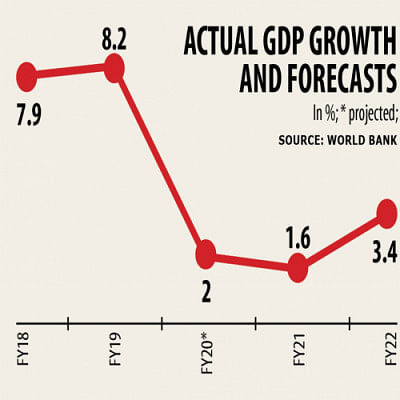World Bank revises up GDP growth projection

The World Bank has revised its GDP growth projection upwards for Bangladesh to 2 per cent for the last fiscal year, although the figure is still far lower than the government's estimate.
In June, the Washington-based lender had said that Bangladesh's economy would grow by 1.6 per cent in FY20 as the coronavirus pandemic battered the country.
It had also forecast the economy to expand by 1 per cent in the current fiscal year.
Yesterday, the lender said in Bangladesh, which had been one of the fastest-growing emerging market and developing economies prior to the pandemic, growth was estimated to have decelerated to 2 per cent in the last fiscal year.
It also revised the growth forecast upwards for the next fiscal year to 1.6 per cent, according to the Global Economic Prospects Update.
"Our provisional estimate is that the GDP had grown by 5.24 per cent in the last fiscal year. It is not reflected in their [World Bank] report," Finance Minister AHM Mustafa Kamal told The Daily Star.
"When we publish the final number, they would accept it."
The government may revise down its GDP growth target to 7.4 per cent for the current fiscal year, as suggested in the documents of the Eighth Five-Year Plan, from 8.2 per cent set in June.
The Covid-19 pandemic has caused deep output losses and contributed to a sharp rise in poverty and unemployment in South Asia.
Output in the region contracted by an estimated 6.7 per cent in 2020, reflecting the effects of the pandemic and nationwide lockdowns, particularly in Bangladesh and India.
Activity rebounded in the second half of last year, led by industrial production, as initial stringent lockdowns were eased.
"In economies that rely on external sources of growth such as manufacturing exports (Bangladesh) and tourism (Bhutan, the Maldives, Nepal and Sri Lanka), the recovery is likely to be particularly modest," the WB said.
The region is projected to grow by 3.3 per cent in 2021.
Weak growth prospects reflect a protracted recovery in incomes and employment, especially in the services sector, limited credit provisioning constrained by financial sector vulnerabilities, and muted fiscal policy support.
The forecast assumes that a vaccine will be distributed on a large scale in the region starting the second half of 2021 and that there is no widespread resurgence in infections.
Risks to the outlook of the region are tilted to the downside, the WB said.
They include more severe and longer-lasting infection rates from the pandemic, financial and debt distress caused by an abrupt tightening of financing conditions or possible widespread corporate bankruptcies, adverse effects of extreme weather and climate change, weaker-than-expected recoveries in key partner economies, and a worsening of policy-and security-related uncertainty.
Additional stress on domestic banks in the region could be triggered by the economic consequences of a more protracted recovery from the pandemic, which in turn could lead to a rise in bankruptcies and weaken the balance sheets of the banking and non-banking sectors in Bangladesh, Bhutan, India, Sri Lanka.
Extreme weather events also remain an important regional risk, the report said.


 For all latest news, follow The Daily Star's Google News channel.
For all latest news, follow The Daily Star's Google News channel. 



Comments